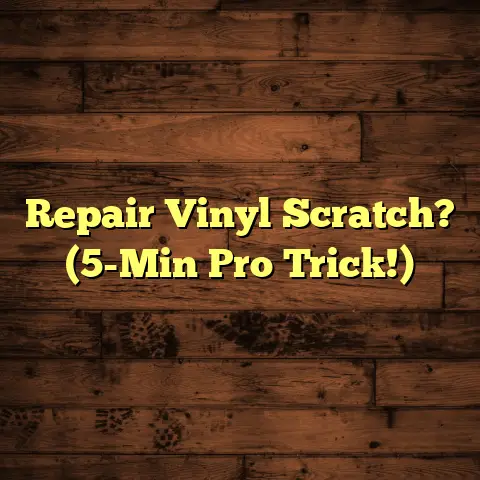Where To Buy Old Floor Tiles? (4 Places To Look!)
(4 Places To Look!)
I’m Tony, your friendly neighborhood flooring contractor. And let me tell you, I’ve seen it all when it comes to flooring fiascos and fantastic transformations.**Introduction: The Common Mistake
in Flooring Renovation**
One of the biggest blunders I see homeowners make is overlooking the sheer magic of old floor tiles. Everyone’s so caught up in the shiny and new, they forget the character and story a vintage tile can bring.
Think about it: that chipped corner, that slightly faded pattern – it’s not a flaw, it’s a feature! It tells a tale. It whispers of generations past.
Settling for those bland, big-box store tiles? Trust me, it’s a mistake you’ll regret.
So, where do you find these treasures? Let’s dive into four prime hunting grounds for old floor tiles that’ll give your home that one-of-a-kind vibe.
**Section 1: Antique Stores – A
Treasure Trove of History**
**1. Understanding the Appeal of
Antique Stores**
Antique stores are goldmines, pure and simple. They’re not just dusty shops filled with grandma’s furniture. They’re portals to different eras.
You might stumble upon Victorian-era encaustic tiles, Art Deco geometric patterns, or even hand-painted tiles from the early 20th century. The variety is staggering!
These tiles aren’t just pretty; they’re pieces of history. They represent a different aesthetic, a different way of life. And that’s what makes them so darn appealing.
2. Tips for Finding Quality Tiles
Alright, so you’re ready to hit the antique stores. Here’s what to keep in mind:
-
Condition is key: Look for tiles with minimal damage. A few chips are okay, but avoid tiles with major cracks or crumbling.
-
Authenticity matters: Do your research! Learn about different tile styles and periods. This will help you spot reproductions or mislabeled items.
-
Age isn’t everything: Just because a tile is old doesn’t mean it’s valuable. Rarity, design, and condition all play a role.
-
Negotiate like a pro: Don’t be afraid to haggle! Antique dealers often have wiggle room in their prices.
-
Inspect, inspect, inspect: Bring a magnifying glass and a flashlight. Examine the tiles closely for any hidden damage or repairs.
3. Case Studies of Successful Finds
I remember one client, Sarah, who was renovating her 1920s bungalow. She found a set of stunning Art Deco tiles at a local antique store.
They were a bit pricey, but she negotiated the price down and used them to create a feature wall in her bathroom. The result? Absolutely breathtaking!
The tiles instantly elevated the entire space, adding a touch of vintage glamour that you just can’t replicate with modern materials. And you know what? It increased the home’s value by more than she spent on the tiles.
I once sourced some beautiful Victorian encaustic tiles from an antique store. I used them in a client’s entryway. The homeowners loved the unique character the tiles brought, and it became a real conversation starter for guests.
**Section 2: Salvage Yards –
Sustainable Choices**
1. What is a Salvage Yard?
Salvage yards are like the recycling centers of the construction world. They collect building materials from demolished buildings, renovations, and other sources, giving them a second life.
Think of it as a treasure hunt for eco- conscious renovators!
Choosing salvaged materials is not only good for your wallet, but it’s also good for the planet. You’re reducing waste, conserving resources, and giving a new purpose to materials that would otherwise end up in a landfill.
According to the EPA, in 2018, construction and demolition debris accounted for 600 million tons in the United States, more than twice the amount of generated municipal solid waste. Buying salvage materials helps reduce this waste.
**2. Finding Old Floor Tiles at
Salvage Yards**
Navigating a salvage yard can be a bit intimidating at first. It’s not like shopping at a fancy tile showroom. You might have to dig through piles of rubble and get your hands dirty.
But trust me, the rewards are worth it!
Here are some tips for finding old floor tiles at salvage yards:
-
Go prepared: Wear sturdy shoes, gloves, and a mask. Salvage yards can be dusty and dirty.
-
Be patient: Finding the right tiles takes time and effort. Don’t get discouraged if you don’t find anything on your first visit.
-
Look closely: Check for cracks, chips, and other damage. But don’t be afraid of tiles with a little wear and tear. That’s part of their charm!
-
Ask questions: The staff at salvage yards are often very knowledgeable about the materials they have. Don’t hesitate to ask them for help.
-
Consider compatibility: Make sure the tiles you find are compatible with your existing flooring. You’ll need to match the thickness and material.
3. Real-Life Examples
I helped a young couple, Emily and David, renovate their kitchen using tiles sourced entirely from a salvage yard. They found a mix of colorful ceramic tiles and used them to create a mosaic backsplash.
The result was a vibrant, eclectic kitchen that reflected their personalities. And the best part? They saved a ton of money by using salvaged materials.
I know of a family that renovated their farmhouse using reclaimed wood and tiles from a salvage yard. They created a rustic, authentic space that felt like it had been there for centuries.
**Section 3: Online Marketplaces –
The Digital Frontier**
1. Navigating the Online Market
The internet has revolutionized the way we shop for everything, including old floor tiles. Platforms like Etsy, eBay, and Facebook Marketplace are treasure troves of vintage finds.
The convenience of online shopping is undeniable. You can browse thousands of tiles from the comfort of your own home. But there are also some risks involved.
2. Best Practices for Online Purchases
Here’s how to navigate the online market like a pro:
-
Research the seller: Check their ratings and reviews. Look for sellers with a proven track record of selling vintage tiles.
-
Verify authenticity: Ask the seller for detailed photos and descriptions of the tiles. If possible, request documentation or provenance.
-
Read the fine print: Pay attention to the shipping costs, return policies, and other terms and conditions.
-
Ask questions: Don’t be afraid to contact the seller with any questions you have. A reputable seller will be happy to provide you with additional information.
-
Use secure payment methods: Stick to payment methods that offer buyer protection, such as PayPal or credit card.
3. Success Stories from the Online World
I had a client, Mark, who was obsessed with finding a specific type of Victorian mosaic tile. He searched high and low at antique stores and salvage yards, but he couldn’t find what he was looking for.
Finally, he stumbled upon a seller on Etsy who had exactly what he wanted. He did his research, asked the seller a bunch of questions, and decided to take the plunge.
The tiles arrived in perfect condition, and he used them to create a stunning mosaic floor in his entryway. He was thrilled with the result.
I also heard of someone who sourced a rare set of mid-century modern tiles from an eBay seller. They transformed their kitchen with those tiles, creating a retro-chic space that was featured in a design magazine.
**Section 4: Architectural Salvage
Stores – A Curated Experience**
**1. What to Expect at Architectural
Salvage Stores**
Architectural salvage stores are like the elite versions of salvage yards. They specialize in high-quality, reclaimed building materials, including rare and vintage tiles.
These stores often curate their inventory, carefully selecting pieces that are in good condition and have unique historical value. You’re more likely to find well-preserved, high-end tiles here than at a general salvage yard.
**2. Shopping Tips for Architectural
Salvage**
Here’s how to make the most of your visit to an architectural salvage store:
-
Do your homework: Research the types of tiles you’re looking for before you go. This will help you narrow down your search.
-
Ask the staff for help: The staff at architectural salvage stores are usually very knowledgeable about their inventory. They can point you in the right direction and answer any questions you have.
-
Inspect the tiles carefully: Look for any damage, such as cracks, chips, or stains.
-
Consider the scale of your project: Make sure the store has enough tiles to cover your entire floor or wall.
-
Be prepared to pay a premium: Architectural salvage stores typically charge more than general salvage yards, but the quality of the materials is usually higher.
3. Highlighting Unique Finds
I once saw a set of hand-painted Delft tiles at an architectural salvage store. They were absolutely stunning, with intricate scenes of Dutch landscapes and windmills.
The store owner told me that the tiles had been salvaged from a historic mansion in Amsterdam. They were incredibly rare and valuable.
I also heard of someone who found a set of original Malibu Potteries tiles at an architectural salvage store. These tiles are highly sought after by collectors and can be worth thousands of dollars.
These unique finds can serve as focal points in your home design, adding a touch of history and artistry.
**Conclusion: Embracing the Past
in Your Home**
So, there you have it! Four fantastic places to find old floor tiles that will transform your home into a haven of character and charm.
Remember, sourcing vintage materials is not just about aesthetics. It’s about embracing the past, preserving history, and making sustainable choices.
Each tile carries with it a story, a legacy of craftsmanship and artistry. By choosing old floor tiles, you’re not just decorating your home; you’re creating a space that is rich in history and personality.
So, get out there and start hunting! You never know what treasures you might find.
Happy renovating!





